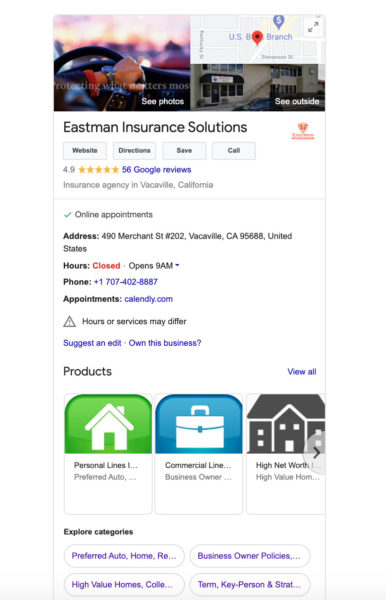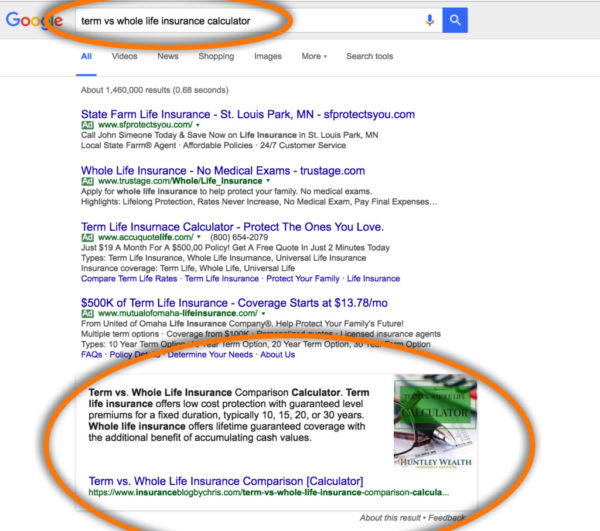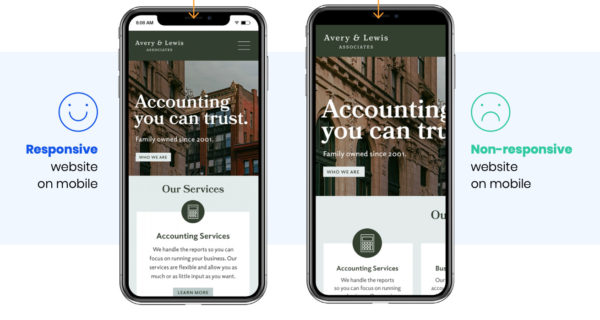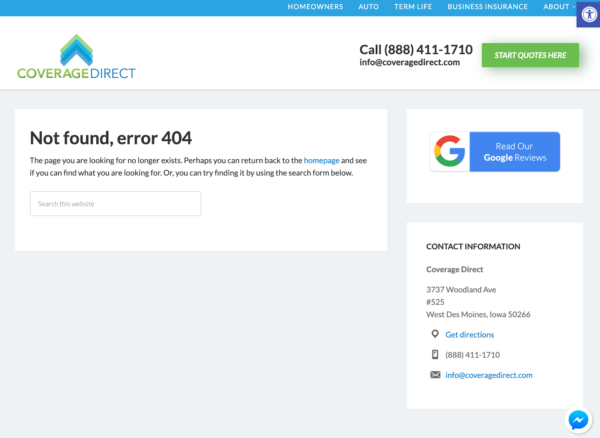When prospective customers are in the market for insurance products, their search almost always begins online. Your services could be exactly what these leads are looking for — but if they can’t find you, they’ll turn to the next best thing.
In today’s digital landscape, quality doesn’t translate directly to visibility. The insurance market is growing rapidly, with agents in fierce competition to reach an audience that demands immediate answers and information. With all this competition, websites of excellent and customer-oriented insurance providers can get pushed further and further down in search results.
Almost 70% of people click on one of the first five websites listed on a search engine results page (SERP). if you’re not there, your potential for success is being constrained by competitors leveraging search engine optimization (SEO).
Why is it important to focus on SEO for insurance agents?
Billions of web pages exist on the internet. Search engines use complex algorithms to sort and organize this vast resource directory so that when a user conducts a search, they’re directed to the best possible results.
At its core, SEO is about using relevant search terms and phrases on your website to help this process along. It’s unlikely that most people search for your business by name, so the trick is to consider what they do type into a search bar. When Google sees that your website matches those queries, the algorithm indexes your business as relevant.
But search engines are businesses, too. Black hat SEO practices like keyword stuffing have kept developers on their toes, requiring consistent search engine algorithm changes to ensure top results deserve their standing. Google updates its algorithm about twice daily.
While you can’t — and shouldn’t — cheat the system, you can leverage its best practices to reinforce your business’s value and position your insurance website as potential leads’ top search result.
What do search engines look for?
When a search engine’s bots crawl the web, they’re looking for more than just keywords. SEO algorithms are built around three main pillars:
AuthorityRelevanceTrust
These metrics are measured by a range of factors — like content quality, link building, and social sharing. But these impacts strengthen over time, and there’s no easy shortcut to accelerate the process.
However, you can design your insurance website to get a competitive advantage. Build your website’s authority, relevance, and trust by delivering what search engines want to see.
15 ways to implement good SEO for insurance agents
How can you maximize your online presence to consistently capture the attention of search engine algorithms? First, lay the groundwork with technical tweaks. After that, move on to optimizing your marketing efforts.
Marketing SEO tactics
Meeting the technical criteria of search engine algorithms helps your website strengthen its measure of trust, authority, and relevance. Optimizing your insurance marketing efforts enhances this growth.
Achieving and maintaining good search visibility is an ongoing process that requires research unique to your client audience, consistency, and evaluation.
These efforts are all about building your reputation as an expert insurance provider, especially at the local level where your potential client base is active. As your business is a part of one of the country’s most competitive industries, practicing SEO-oriented marketing can help define your image as a provider, sifting your services to the top of the heap.
1. Do keyword research
Keywords are the words and phrases your audience uses when looking for answers online. Developing your keyword list can uncover what questions you should target and what topics are most popular among your prospective leads.
While they’re no longer the most important part of SEO — just part of the larger puzzle — an effective keyword list helps inform your marketing strategy. They’re guides that reveal user intent and expectations.
Keyword research begins with understanding your target client. Consider your unique value proposition — what you offer above other options — and what individuals benefit from your services.
Identifying this value helps you build a target client profile and define the person whose interest you want to attract. From there, you can segment your overall market to individual niches based on features like insurance products and demographics.
To kick off your keyword research process:
Make a list of relevant topics based on the insurance products you offer.Fill in each of these topic lists with specific words and phrases — also called long-tail keywords — your target client might use in their search intent.Research related keywords, like those that appear as suggestions when you type in a topic to Google.Analyze your list with a keyword research tool and prioritize those with higher volume but lower competition.Revisit this process periodically and tweak your list to reflect changing trends.
For most insurance companies, this process should focus heavily on local search terms. Search engines strive to link users with the most relevant content. One way they do this is to use IP addresses to match people with content near their physical location.
For example, if a person from Philadelphia searches for “Pennsylvania insurance,” Google will prioritize results from their location. If your company is in Pittsburgh, your local SEO for insurance agents will be more effective in targeting that keyword than competing with search terms that capture other local markets.
Additionally, national companies like Geico and Allstate have the resources to consistently market and compete for these more general search terms. Your agency will gain better visibility from local and niche search terms that appeal to your audience and demonstrate your specific value.
2. Develop your on-page SEO
Building your keywords is your first step — but it also matters how you use them.
Best practices for using keywords for on-page SEO include:
Including targeted keywords in title tags of each page, limiting titles to about 60 charactersWorking keywords into H1 Headings, but only using these headings once per pagePutting keywords into URLs where possible, but keeping them shortAdding alt text to images, invisible to the average user but critical for search enginesLinking internally to other pages on your website
Ultimately, however, no amount of keyword use can overcome poorly written content. Make sure you’re writing for your audience and not just for search engines. Your content should:
Have perfect grammar and spellingBe worded for the average person — at about an 8th-grade reading level, with as little jargon as possibleBe scannable for people, with a structure that includes H2 and H3 tags for search botsIncorporate imagery and appeal to people’s visually-driven attention spans
3. Leverage your off-page SEO
Working on off-page SEO involves building your website’s domain authority through backlinks. When another reputable and high-traffic source publishes a link to your website, these backlinks inform search engines that you’re relevant and trustworthy.
This strategy also grows the number of ways people can find your agency’s services. The latter increases your traffic, which is another algorithm measurement of relevance.
When it comes to earning these backlinks, quality beats quantity. You may extend your insurance agency’s reach by:
Sponsoring events or local organizations to earn a link on their websiteWriting a guest post for an industry blog, association e-newsletter, or publication like PIA or Trusted Choice Contributing an article to a local newspaper about a consumer-facing topicUsing Help A Reporter Out (HARO) to respond to writers looking for quotes from an insurance expertEngaging with blog comments on high-traffic websites in your insurance market
You can also take advantage of existing tools that extend your web presence, including local business directories like:
YelpAgentReviewYour local Chamber of CommerceThe Better Business BureauYellowpages.comWalletHub
4. Use Google My Business
Among local listings, Google My Business (GMB) deserves major attention.
Because it’s embedded right into Google’s search engine — where more than 90% of searches occur — this platform is one of the most effective ways to rank high in local search results.
GMB listings are prioritized in local searches, appear on Google Maps, and position your contact information prominently. Your listing can also highlight client reviews, featured photos, and even recent blog content.
While GMB can help build your authority and thin the competition, it still requires an active presence. Build and maintain a compelling GMB profile by:
Making it comprehensive and including all relevant informationUsing your best-performing local keywords in the business descriptionAdding content like blog posts and imagesCreating an event if you’re giving a speech or organizing an industry functionKeeping all details updated to reflect any changes
 High-ranking Eastman Insurance Solutions uses its GMB profile to collect reviews, promote products, connect its social media accounts, and even facilitate appointment scheduling.
High-ranking Eastman Insurance Solutions uses its GMB profile to collect reviews, promote products, connect its social media accounts, and even facilitate appointment scheduling.
5. Build social proof
Social proof is the idea that if others endorse something, we’re more likely to choose it ourselves. It’s the reason that nearly nine out of ten people read online reviews before making a purchasing decision.
Reach out to your current and past clients to request a review on your Google My Business or Yelp profiles. Most people will be happy to oblige — research shows that 70% of people will take the time to leave a review when asked.
Reviews also impact the power of SEO for insurance agents:
Google uses them to determine if your business meets your clients’ demands.They increase traffic and conversion rates, signaling to search engines that your services offer a solution.As clients post reviews, they’re organically giving Google more keywords to use to promote your insurance products
6. Consider paid advertising
While organic SEO techniques take time to grow, pay-per-click (PPC) ads can help your website appear at the top of search results with some strategic keyword bidding.
In a PPC ad campaign, you place a bid on a keyword and only pay the fee if someone clicks on your link that’s delivered by the search engine. Local and niche search terms are typically less competitive than their general counterparts, meaning you have a better chance of ranking high at a lower cost.
You can use the Google AdWords Keyword Planner to analyze the volume and cost of specific keywords. This tool will also offer suggestions it thinks are useful for your campaigns.
A PPC campaign can promote your Google My Business profile, as well. It’s an excellent way to advertise your services alongside your five-star Google reviews.
7. Lean on content creation
To fully optimize your website’s SEO for insurance agents, give search engines more content to work with.
Your keyword research helps identify topics popular among your niche audience. Think about the intent behind these searches and what answers they are after — then use your blog to provide the solutions.
Content marketing is the darling of SEO strategies because you can create valuable resources that position you as an expert to clients and search bots alike, while:
Building awarenessMaking use of niche keywordsImproving your ranking, as search engines prioritize regularly-updated websitesIncreasing your potential for backlinks
 Utilizing long-tail keywords, life insurance agent Chris Huntley’s blog post appears as the top organic answer to this search query — ranking higher than any landing page, as it brings specific value.
Utilizing long-tail keywords, life insurance agent Chris Huntley’s blog post appears as the top organic answer to this search query — ranking higher than any landing page, as it brings specific value.
Blogs also give you fresh content to share across your other marketing efforts — like LinkedIn, Google My Business, or your email list. Actively posting content your audience finds valuable increases engagement and reinforces your expertise. For search engines, it also boosts your authority.
Build your content strategy by creating a list of topics — like those based on your keywords — to guide what you’ll write about. This could include:
Detailed answers to common questions, concerns, and pain pointsHelpful tips related to your target market or what that market seeks to insure, like property maintenance or planning for retirementContent that appeals to a specific group, like new homeowners or parentsInterviews with clients or case study to reinforce your products’ valueScannable explainers to relay updates relevant to policyholders
While implementing marketing SEO tactics is the most common, and arguably the easiest, way to improve your SEO, it’s not the only way. And to get the most out of your SEO efforts you should include some technical strategies as well.
Technical SEO tips
These technical changes curry favor with search engines while improving your audience’s website experience.
8. Optimize for mobile
More than 60% of Google searches happen on a mobile device. Websites that aren’t mobile-responsive get distorted on smartphone or tablet screens, making it difficult to navigate and interact with the content.
Ensuring your pages look great and work well on a mobile device enhances the user experience, reducing bounce and keeping visitors browsing your website. Google considers this value so necessary that as of 2020, it will prioritize mobile-optimized web pages, indexing websites based on their mobile versions first.
 As seen in Constant Contact’s professional services marketing guide, optimizing your page for mobile isn’t just more visually appealing to your target customer, it’s critical to compete in search engine rankings.
As seen in Constant Contact’s professional services marketing guide, optimizing your page for mobile isn’t just more visually appealing to your target customer, it’s critical to compete in search engine rankings.
You can test your website with Google’s Mobile-Friendly Test and enhance its SEO by:
Ensuring your website layout looks good on both mobile and desktopUsing easy, touch screen–oriented navigation — like larger buttons and auto-fill formsAvoiding website popups that are difficult to close with a touch screenConsidering Accelerated Mobile Pages (AMP), which can help websites load fasterRemoving Flash elements
Using an online tool like Constant Contact’s intelligent website builder is a great option. You’ll get a responsive website that looks great on any device and seamlessly updates with all future edits.
9. Ensure fast loading times
The majority of people abandon a website when it takes more than 3 seconds to load. A slow-loading website isn’t just bad at keeping customers’ interest, however. Search engine bots are clued into this behavior and prioritize faster pages.
You can test your page speed with Google PageSpeed Insights. It analyzes your website and offers feedback for its improvement, such as:
Reducing file and image sizesActivating “lazy loading” so page elements only load as users scrollGetting rid of unnecessary content that slows things downUpgrading your web hostMinimizing the use of plug-ins
10. Build trust with HTTPS security
In 2014, Google announced that website security had been added as an official ranking factor for their algorithm. Installing a secure sockets layer (SSL) on your server ensures any information and data collected by your website is encrypted, a standard expected by your insurance clients.
You can contact your hosting company to enable an SSL certificate for your website. But keep in mind that when you first make this upgrade, you may need to migrate your web content to its new HTTPS home.
11. Create an organized website structure
A good website structure depends on how well content is organized, linked, and presented to online visitors. It’s an important feature for user experience, offering clear navigation so that new leads can find the answers they’re after.
But how you group content also signals to search engines what’s most important, giving you more control over its visibility. Audit how your website looks and operates. Enhance its structure by:
Removing outdated or irrelevant contentOrganizing content logically by categoryUsing breadcrumb menus Linking internally to your most important blog posts, resources, or topicsAdding tags in moderation
12. Check your robots.txt
An organized website helps search engines navigate, but you can offer these bots even more direction. Your page’s robots.txt file includes code that tells Google where to go — and if certain files are unintentionally blocked, the bots can’t get the full picture.
You can test to see if you have an existing file by searching “yourdomain.com/robots.txt.” If none exists, you can add a new file to your root directory.
If you have a small website, you can simply allow bots to access all files and specify the sitemap location. Make sure that important content or folders aren’t blocked, because that would discourage indexing. As your web presence grows, you can use the tool to organize what you want search engines to see and prioritize.
13. Add structured data
Also known as schema markup, structured data is how you describe your content to search engines. This text is invisible to website visitors but gives bots key details, like:
Contact informationHours and areas of operationServices and products offered
Though this information is coded, most domain providers have plug-ins and tools to help you seamlessly add these details to your website. You can also use Google’s own Structured Data Markup Helper to generate schema markup code.
14. Customize 404 pages
A 404 page is what people see if a URL they visit doesn’t exist. This usually happens when a page has been deleted or a link is misspelled. Customizing your 404 pages helps ensure smooth website navigation for your users while boosting its SEO.
Check what your 404 page looks like by searching for a URL that doesn’t exist on your website, and make sure it’s optimized with:
A similar structure, navigation menu, and design as your websiteA short message that the page does not existPage suggestions, like your most popular blog posts or link to your services pageContact informationA search bar so users can find exactly what they’re looking for
 The agency Coverage Direct makes it easy to reorient if you’ve landed on a 404 page. The 404-page design includes a search function, full contact information, and more.
The agency Coverage Direct makes it easy to reorient if you’ve landed on a 404 page. The 404-page design includes a search function, full contact information, and more.
15. Clean up your sitemap
Your sitemap is the blueprint search engines use to understand your website. Optimizing yours puts your website’s best foot forward so that bots discover your best content.
Organize your sitemap by:
Submitting it to Google and other search engines to test for errors and get a sense of what search engines currently seeIncluding only important website content — like your service categories, contact information, and popular blog postsRemoving pages that don’t have original content
Depending on the scope of your audience and services you offer, there are other tools at your disposal to grab the attention of search bots, like:
AMPs PaginationMultilingual content
What are the next steps after following SEO best practices?
Search engine algorithms are constantly changing — which means your strategy must evolve, too. You can use free tools like Google Analytics to measure your SEO implementation’s impacts and audit your efforts. Tweak as you go and stick with what’s working.
These SEO findings can enhance all of your marketing efforts — from social media to direct email, content marketing to web design. Check out Constant Contact’s marketing guide, The Download, which breaks down each of these visibility-boosting avenues. Incorporate your SEO strategy across all the tools and platforms at your disposal to bring in more and more valuable insurance leads to your business.
The post 15 Tips to Improve SEO for Insurance Agents appeared first on Constant Contact.
Read more: blogs.constantcontact.com
